Nestlé teams up with EPFL for food-brain research
to be realised, and Nestlé underlined its intentions yesterday to
get a head start on the competition with the signing of an
agreement with the Swiss Federal Institute of Technology (EPFL) to
expand the role of nutrition in cognitive function.
The agreement will also further research into taste and flavour enhancement, an area in which Nestlé and the EPFL have already an established and successful partnership.
"The signature with EPFL is the beginning of a new era," said Peter van Bladeren, director of the Nestlé Research Center in Lausanne.
Van Bladeren outlined the three research areas for the future, including the role of nutrition in cognitive development in children, the prevention of cognitive decline in the elderly, and to better understand the gut-brain axis.
"In addition, we have a fourth axis: Perception," he said. "How do we smell, taste and see food, which is a continuation of an already successful partnership."
The agreement with the EPFL, Nestlé's largest collaboration with a university of research institute, will see the company contributing up to CHF 5 million (€ 3.1 million) every year for five years, with a review after four years to potentially extend the project further.
"It is an unprecedented partnership that we are signing with Nestlé," said Patrick Aebischer, president of the EPFL. "And it's even more meaningful because it opens up perspectives for all of us in terms of health, knowledge, and pleasure."
Nestlé's support will fund the establishment of two endowed chairs at EPFL, fund specific projects to support the fundamental science, and then push for clinical trials and full development of potentially beneficial ingredients or food products.
The project with EPFL has been spurred on by recent developments and breakthroughs in neuroscience, most notably, said van Bladeren, that the brain doesn't remain fixed after early development with damage being irreparable, but continues to change throughout a person's life, with damaged cells being repaired and new ones made.
"We now know that diet can have very beneficial effects on the mature and aging brain," he said.
The link between nutrition and cognitive function is an area that has largely been overlooked. But recent studies looking at the potential protective role of foods like pomegranate and berries, green tea, and fish being against cognitive impairment and the on-set of Alzheimer's disease shows that this is slowly changing.
And this, says Nestlé, offers opportunities.
"As we have seen in the past 20 years with the prevention of cardiovascular diseases, we will see, starting now, the prevention of neurodegenerative diseases in the next 20 years," said Dr. Sandrine Andrieu from the Toulouse University School of Medicine.
Currently, about 12 million people in the US plus the EU suffer from Alzheimer's, with some estimates predicting this figure will have triples by 2050. The direct and indirect cost of Alzheimer care is over $100 bn (€ 81 bn) in the US alone. The direct cost of Alzheimer care in the UK was estimated at £15 bn (€ 22 bn).
The risk factors for Alzheimer's disease are metabolic, said Andrieu, and include cholesterol, diabetes, hypertension, high homocysteine levels, and obesity. Another risk factor is oxidative stress, she said.
The opportunities appear to come from two approaches - improving the energy delivered to the brain (metabolism behind brain energy slows down during ageing and Alzheimer development) and improving the overall metabolic profile of the person (traditional ingredients, phytonutrients, bioactive lipids, pre- and probiotics) to reduce the risk of developing the disease.
Nestlé already has several proprietary ingredients that contribute to energy production, including the ActigenE mixture of micronutrients such as B vitamins, vitamin C, magnesium, iron and calcium, and the Nutriactive B containing vitamins A, B, C, D, and E and minerals.
Aebischer said that no single compound or nutrient would be the focus of the study, because be doing such would enter the realm of pharma and produce toxicology issues. Dr. Aebischer said the formula would be "put together by nature."
However, Prof. Van Bladeren told NutraIngredients.com that Nestlé would be looking at a range of new and existing ingredients and investigating novel ways of delivering and improving the bioavailability, thereby giving Nestlé a proprietary ingredient.
"We can find a novel form of a natural ingredient," said van Bladeren.
An example of this approach, although not related to Alzheimer's, was recently published by NRC researchers in the Journal of Nutrition (Vol. 136, pp. 404-408). Dr. Gary Williamson and his co-workers used enzyme modification of the citrus flavonoid, hesperidin, to alter the area of absorption in the intestine and therefore improve the bioavailability of the polyphenol. For the report from FoodNavigator.com's sister site, visit: NutraIngredients.com
Another example is Nestlé's innéov lycopene supplement, the first move by Nestlé into the dietary supplements market, but not yet commercially available. To improve bioavailability the NRC researchers produced a form of lacto-lycopene, giving the company a patentable form of an existing nutrient.
The agreement with the EPFL could also mark a shift in Nestlé's research partnerships, which currently extend to 140 universities, research institutes and medical centres worldwide.
"[The agreement with EPFL] is the first in what we hope to be a number of more focused, large-scale cooperation agreements with the best research institutes around the world," said van Bladeren. "There might be fewer, but more important partnerships in the future."
Nestlé currently spends CHF 1.5 billion (€ 0.94 billion) on R&D, equivalent to 1.6 per cent of the company's annual turnover.
"Nestlé is in the midst of a strategic transformation into a nutrition, health and wellness company," said Werner Bauer, Nestlé's executive vice president. "And R&D will increasingly drive and contribute to the acceleration of this process as we go forward."
















